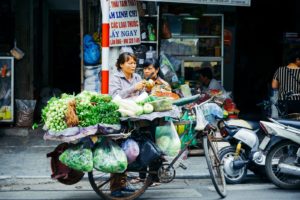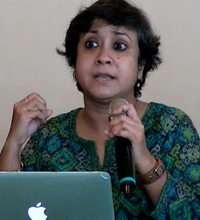In the era of post-globalisation and trade agreements that have traversed from the multilateral (read WTO), bilateral and plurilateral, and now to mega trade deals such as the TPP1 and RCEP2, it is clear that trade policy is creating an increasingly gigantic influence on all our lives including on women’s lives. The discussion on trade and gender impacts has become even more important today as there is increased attention on it in trade fora, but the proposed solutions reflect very different and often problematic approaches.
THE GENDERED IMPACTS OF TRADE AND INVESTMENT AGREEMENTS
Are women affected differently by trade policy which is gender-neutral on paper? There is clearly a gendered impact of trade liberalisation because women suffer from unequal positions vis a vis economic, social and political relationships. This impacts how, if at all, they benefit from trade liberalisation, but also how they lose from it. Literature indicates that while women benefit less than proportionately from trade liberalisation, they bear a much higher share of the adverse impacts due to their unequal access to resources an power3.

The adverse impact is visible in traditional areas of trade in both agricultural and industrial goods, sectors where women are engaged as producers, workers and consumers. For example, in India agriculture employs about 75% of women farmers and workers, who are already struggling with increasing costs of production. Now they face competition from imported products coming in through the Free Trade Agreements (FTAs), especially in plantation production which is reeling rom the impact of the India-ASEAN FTA. Western agricultural subsidies has also led to massive over-production and dumping in global markets, leading to a price fall for developing country farmers. In industrial work, women are getting higher opportunities in trade oriented sectors such as garments. But work is mainly informal, casual, and highly exploitative. This is especially visible in the trade oriented Global Value Chains (GVC) that exploit cheap, unorganised labour such as of women in developing countries to earn sky-high profits.
In the service sector, the impact on employment is already felt by women retailers in India (as in many other developing countries). Retail used to provide about 16-25% of total jobs to women who are already facing competition from domestic large retail chains. But now, with the easing of foreign investment norms4, they face competition from giant foreign supermarket chains with financial resources to give discounts till they capture the market. Not only employment, but access to critical services such as healthcare, energy and water are also impacted by trade policy, often with different outcomes for women.
The stringent patent protection norms set by the WTO-TRIPS5 Agreement and pushed further by TRIPS-plus Intellectual Property Rights provisions in FTAs, have already been pushing medicine prices to record highs. Women who suffer from disproportionate access to healthcare products and services are bearing a heavier burden from this. In India, talking to HIV/AIDS affected couples revealed how, due to high prices of patented medicines, women give up treatment in favour of the male bread-winner. This happens in spite of India being known as the world’s pharmacy because of its generic medicine industry, which produces copy-medicines at low prices. But this industry is now under threat from strong IPR provisions in several FTAs that India is negotiating.
Further, foreign investors enjoy strong protection under the FTAs’ investment chapters and the stand-alone bilateral investment treaties (BITs), about 3300 of which proliferate in the world today. To top it, a multilateral investment facilitation agreement is now being proposed in the WTO. The investor-state-dispute-settlement (ISDS) clauses under these agreements are thwarting regulatory spaces of governments worldwide by allowing foreign investors to sue governments in secret international arbitration cases for any breach of their perceived profits from an investment, even if it is a (development) policy measure. This has led to severe policy freezes, including for ensuring the rights of women, indigenous peoples, workers etc; has increased tendencies for land and natural resources grabs; and challenged environmental and even public health regulations.
Notably, the adverse impact is visible even more strongly in the “new issues”, or the new areas that are seeing a push for liberalisation in the WTO and the FTAs, mainly at the initiative of the developed countries. This includes investment liberalisation or facilitation already discussed above, liberalisation of e-commerce, government procurement, competition policy and so on, all of which deeply involve policy space, including development policy space, which is key to realising women’s rights in many ways. In addition, these are areas which tend to benefit more the economically rich and socially powerful groups.
WTO SOLUTIONS MORE PROBLEMATIC THAN THE PROBLEM?
Interestingly, after decades of progressive women’s rights groups’ claims that there is a gender impact of trade which was not taken seriously, the 2017 Ministerial of the WTO in Buenos Aires suddenly decided to come up with the “Buenos Aires Declaration on Trade and Women’s Economic Empowerment”6. Pushed by a WTO Member Coalition, this Declaration received endorsements from 121 Member States who “agreed to collaborate on making our trade and development policies more gender-responsive”, by sharing experiences and best practices, generating gender responsive data and so on7.
However, instead of being good news, this initiative rings several alarm bells. First, this document does not propose any new approach to the WTO’s way of working or its agreements. Instead of assessing the negative gendered impacts in multiple areas (as described above) of such liberalisation, it proposes more liberalisation as the ultimate solution and a key driver for women’s empowerment. A few cosmetic words here and there cannot change nor address this. Further, the initiative has the potential to make the WTO agreements sound very beneficial for women if gender issues are addressed in very trivial and perfunctory ways.
The declaration also mentions areas such as government procurement, e-commerce, MSMEs, and GVCs, all of which are “new issues” in the WTO and have no agreed mandate for WTO intervention or rule making. These are also areas where rule making has been resisted by most developing and least developed countries as these constrain their policy space and push new forms of liberalisation, often in disguise, for which they are not ready. Liberalisation of these areas could in fact create adverse impacts on weaker constituencies in developing countries, including women as described above.
The apprehension is corroborated by the fact that the follow-up discussion schedule proposed by the WTO and partners covers topics such as government procurement and the digital economy, all new issues not under WTO mandate, but not on important traditional issues such as agriculture; informal work of women in export industries; and access to medicines, services and natural resources; many of which are seen to be important issues for women in developing countries.
This Declaration does not seem to have any mandate from or been designed in consultation with progressive women’s rights groups that have been raising concerns about gender and trade for a long time. This is reflected in a letter8 which was released in response to the Declaration and was endorsed by 164 (now about 190) women’s rights groups and their allies. This challenged the premise of the Gender Declaration and called on Member States “to refrain from adopting the proposed “Joint Declaration on Trade and Women’s Economic Empowerment”. It said “we appreciate that governments are increasingly recognising the gendered impact of international trade and trade rules imposed through the WTO and preferential trade agreements. However, this declaration fails to address the adverse impact of WTO rules and instead appears to be designed to mask the failures of the WTO and its role in deepening inequality and exploitation”.
They argued that in any case women’s rights groups felt that gender and trade in any fora must be discussed and acted on with their engagement, consent and based on their recommendations. The current approach in the WTO indicates instrumentalisation and misuse of women’s rights groups’ genuine concerns on gender impacts of trade by using them as a Trojan horse.
A question to explore is also which space is best suited for achieving gender equality or readjustment against the adverse impacts of trade policy and liberalisation. Is it the trade agreements, or should it be done in other enabling spaces such as the Human Rights mechanisms, or should it be done through domestic policy i.e. through a mix of enabling domestic macroeconomic policy (including sector-specific policies) and supportive policy to trade policy. In the current scenario of hard trade negotiations driven by large commercial interests and influenced directly by mega MNCs, the latter two are clearly better spaces. The overall approach of trade agreements, at multilateral, bilateral and plurilateral levels, has so far been to push for more aggressive liberalisation which works against women’s rights and equality in general. As long as this approach does not change, talking or attempting to make rules about gender and trade remains cosmetic and is actually an effort to hijack issues of real concern to simply push more liberalisation. It is also clear that any effort to address gender and trade has to be encased in an enabling trade policy for developing countries without which women in these countries cannot benefit.

NOTES
1 The Trans-Pacific Partnership was signed by 11 Members across the Pacific after USA pulled out after Trump took office.
2 The Regional Comprehensive Economic Partnership is being negotiated between the 12 ASEAN countries, and China, Japan, South Korea, Australia, New Zealand and India.
3 See for example Van Staveren, Irene, Diane Elson, Caren Grown and Nilufer Cagatay (eds.). 2007. The Feminist Economics of Trade, Routledge, London and New York. For a literature survey see Sengupta, Ranja and Abhilash Gopinath. 2009. The Current Trade Framework on Gender Linkages in Developing Economies: An Introductory Survey of Issues with Special Reference to India. December. New Delhi: CENTAD and Heinrich Boll Stiftung; For a short a survey of issues https://www.twn.my/title2/unsd/2013/unsd130903/gender-related%20impacts%20of%20int%27l%20trade%20and%20investment.pdf
4 In India 100% FDI is allowed in single brand, and more recently 51% FDI is allowed in multi-brand retail if states opt for it.
5 Trade-Related Aspects of Intellectual Property Rights Agreement of the WTO.
6 https://www.wto.org/english/thewto_e/minist_e/mc11_e/genderdeclarationmc11_e.pdf
7 Some other FTAs by EU and Canada are also attempting to include very general language on gender in preambles without much depth or enforceability such as the EU-Chile FTA and the CPTPP.
This article is published in the DAWN Informs July 2018.
